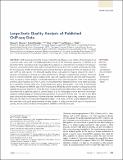Large-Scale Quality Analysis of Published ChIP-seq Data
Author(s)
Kundaje, Anshul; Marinov, Georgi K.; Park, Peter J.; Wold, Barbara J.
DownloadMarinov-2014-Large-scale quality.pdf (1.642Mb)
PUBLISHER_CC
Publisher with Creative Commons License
Creative Commons Attribution
Terms of use
Metadata
Show full item recordAbstract
ChIP-seq has become the primary method for identifying in vivo protein–DNA interactions on a genome-wide scale, with nearly 800 publications involving the technique appearing in PubMed as of December 2012. Individually and in aggregate, these data are an important and information-rich resource. However, uncertainties about data quality confound their use by the wider research community. Recently, the Encyclopedia of DNA Elements (ENCODE) project developed and applied metrics to objectively measure ChIP-seq data quality. The ENCODE quality analysis was useful for flagging datasets for closer inspection, eliminating or replacing poor data, and for driving changes in experimental pipelines. There had been no similarly systematic quality analysis of the large and disparate body of published ChIP-seq profiles. Here, we report a uniform analysis of vertebrate transcription factor ChIP-seq datasets in the Gene Expression Omnibus (GEO) repository as of April 1, 2012. The majority (55%) of datasets scored as being highly successful, but a substantial minority (20%) were of apparently poor quality, and another ∼25% were of intermediate quality. We discuss how different uses of ChIP-seq data are affected by specific aspects of data quality, and we highlight exceptional instances for which the metric values should not be taken at face value. Unexpectedly, we discovered that a significant subset of control datasets (i.e., no immunoprecipitation and mock immunoprecipitation samples) display an enrichment structure similar to successful ChIP-seq data. This can, in turn, affect peak calling and data interpretation. Published datasets identified here as high-quality comprise a large group that users can draw on for large-scale integrated analysis. In the future, ChIP-seq quality assessment similar to that used here could guide experimentalists at early stages in a study, provide useful input in the publication process, and be used to stratify ChIP-seq data for different community-wide uses.
Date issued
2013-12Department
Massachusetts Institute of Technology. Computer Science and Artificial Intelligence LaboratoryJournal
G3: Genes-Genomes-Genetics
Publisher
Genetics Society of America
Citation
Marinov, G. K., A. Kundaje, P. J. Park, and B. J. Wold. “Large-Scale Quality Analysis of Published ChIP-Seq Data.” G3: Genes-Genomes-Genetics 4, no. 2 (March 13, 2014): 209–223.
Version: Final published version
ISSN
2160-1836